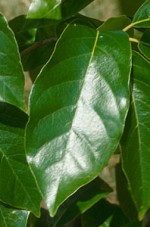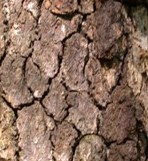
Also known as black tupelo, sour gum and pepperidge, this tall, straight, symmetrical deciduous tree is a native of northeastern United States from Maine to Florida and west to Texas. Large, glossy, leathery leaves are dark green in summer but turn yellow, red, and purple in fall, a breath-taking sight. The flowers that appear in spring are inconspicuous but nectar-rich and are favored by honey bees. The bluish-black berry-like fruits that are produced in fall are an important source of food for many birds and other wildlife. The branching pattern and the dark gray bark produced in blocky ridges are attractive in winter. Black gum prefers moist, well-drained soil in full sun but tolerates heavy clay soils and some shade and pollution. It is a good shade tree in large spaces and is especially attractive near a stream or pond. The genus name, Nyssa, honors the mountainous district of Nysa (Νῦσα) in Greek mythology where the rain nymphs, the Hyades, raised the infant god Dionysus. The specific epithet, sylvatica, comes from the Latin word silva, meaning forest, and refers to woodland habitat of the tree.

Type: Deciduous tree
Outstanding Feature: Fall coloration
Form: Pyramidal; dense horizontal branching
Growth Rate: Slow to medium
Bloom: Inconspicuous greenish flowers in spring; male and female flowers on different trees
Size: 30-60 ’H (to 100’ in the wild) x 20-30’ W
Light: Full sun to partial shade
Soil: Average, moist, well-drained, pH 5.5-6
Hardiness: Zones 4-9
Care: Prune in late autumn if necessary
Pests and Diseases: Leaf spot, rust, tupelo leaf miner
Propagation: Seeds, cuttings
Comments: Difficult to transplant because of long taproot; protect from wind in the northern part of its range.
Outstanding Selections: ‘Autumn Cascade’ (small, weeping).
